Art History Text Book Written From a Catholic World View
The Catholic Textbook Project's goal is to produce loftier-quality history textbooks that teach from a Catholic worldview. Somewhen, they intend to produce books for all grade levels. However, they began with the upper-course levels first, and five main textbooks are bachelor thus far. (They accept also published six state and regional history supplements for fourth class and a U.S. history supplement for the second book of Light to the Nations. I haven't reviewed the supplements.)
The textbooks are adequately similar to standard history texts in methodology and presentation. Even so, the inclusion of the Catholic perspective means that some events are presented with a different slant and some events and people are included that might be skipped in a non-Catholic presentation. In addition, the overall telescopic and sequence leans somewhat toward a western civilisation emphasis. Even with a Catholic emphasis, the texts avoid the temptation to make the actions of Catholics ever look good in contrast to those with other religious beliefs.
All of the Catholic Textbook Project textbooks are hardcover books that are illustrated in full color. The textbooks are written in more of a narrative fashion than many traditional texts, so they are fairly interesting to read. All of the student texts include affiliate review questions and action suggestions. From Bounding main to Shining Ocean and texts to a higher place that level add chapter summaries of key points. Both volumes of Light to the Nations, also as Lands of Promise, add lists of fundamental concepts, dates to retrieve, and central characters at the end of each chapter.
The teacher's manuals do non reprint student textbook pages. They accept all-encompassing teaching material for each chapter that includes a chapter overview, chapter goals, paragraph-long explanations of each key piece of information students should primary, vocabulary terms and definitions, review questions, optional activities, sample quiz and exam questions, and answers to all of the questions. Sample questions can be used to construct your own tests, although this is a bit of work.
Student workbooks have activities for subsections of chapters so students are continually reviewing and reinforcing chapter content rather than simply answering terminate-of-affiliate questions. Workbook questions emphasize comprehension rather than deeper thought as do some end-of-chapter questions. Question formats are make full-in-the-blank, matching, circling, true/imitation, underlining, and crossword puzzles. There are also map labeling, drawing, and maze activities.
From Sea to Shining Body of water: The Story of America
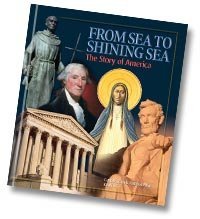 Publisher's suggested grade levels: v-8
Publisher's suggested grade levels: v-8
Outset with early explorers such as St. Brendan and Leif Ericsson, this text tells the story of the United States up through the 1800s. Note that the text begins with the story of a saint, and it concludes with a chapter titled "Catholics in America." While a Catholic viewpoint crops up from fourth dimension to time throughout the residue of the text, the presentation is non at all heavy-handed. In fact, in my opinion, this text could take used fifty-fifty more Cosmic perspective. Missing, for example, are whatever mention of the Know Nothing movement and the evolution of the Catholic school organization. However, the text is suggested for students in grades v through nine, and both topics do testify up in Lands of Promise and Promise. Overall, this is an excellent text and one of the all-time choices up through eighth class. I would generally recommend that ninth graders apply the more-challenging text, Lands of Promise and Promise, for U.Southward. history. However, if yous use All Ye Lands in sixth or 7th grade, it makes sense to follow information technology with From Sea to Shining Sea.
With 206 pages, the educatee workbook offers substantial review and reinforcement for the lessons in the text. Yet, it seems targeted at the lowest end of the historic period spectrum with activities mostly appropriate for fifth and sixth graders rather than 8th and ninth. Activities include fill-in-the-blanks, matching, crossword puzzles, cartoon, coloring, and map work. These activities work within the comprehension and memory realm rather than requiring students to do deeper thinking. Questions in the Chapter Activities that appear in both the student text and teacher'due south manual do stretch students to deeper thinking, but there are but a couple of these questions for each chapter. An reply key for the workbook is also included on the CD-ROM. I would accept loved to meet potential questions or even tests and quizzes themselves included on the CD-ROM to make test creation simpler for teachers and parents. The publisher tells me this is something they are working on.
All Ye Lands: World Cultures and Geography, 2011 revised edition
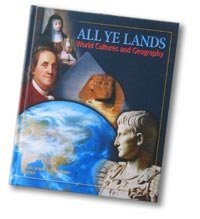 Publisher'due south suggested form levels: 6-8
Publisher'due south suggested form levels: 6-8
Major improvements and revisions were made to this second edition of All Ye Lands. The text is aggressive in scope. While the purpose is the coverage of globe geography and cultures, it also attempts to present an overview of all of history by highlighting particular events and civilizations.
The first chapter introduces geography, then brief sections on geography appear at the beginning of most chapters. A "Things to Do" department at the terminate of about capacity provides map piece of work activities. These usually include drawing and labeling, merely they sometimes stretch into other topics such as longitude and latitude. Political maps are included throughout the text.
I very much capeesh the rewrite of the second affiliate on prehistory. It makes information technology a little clearer than did the commencement edition that early man was of a unlike category than apes. It makes a definite statement that all people descended from Adam and Eve. However, I question its presentation of homo erectus as an ancestor of homo sapiens since current genetic research shows that human erectus, at best, might descend from a predecessor mutual to both domicile erectus and homo sapiens rather than being an ancestor. The text also accepts an old age for the world and living creatures. In spite of the potential mistake regarding human erectus, considering of the nuanced presentation regarding prehistory, I think that both those who believe in development, as well as those who reject it, should exist able to work with this text. For case, on the same page every bit the information about homo erectus it says, "Based on several $.25 of show they have discovered, scientists have ended that human-like creatures have been on the earth for at least one 1000000 years. This is not a fact, but a theory—an idea we form to explain facts we discover" (p. 24). Yous might want to add your ain discussion regarding evolution and creation with your children at this indicate.
While views on prehistory might be debatable, once the text moves on to the Sumerian and Egyptian cultures (still in the second chapter), information technology is on firmer historical ground. Information technology provides an excellent overview of earth history and cultures. Granted, it is selective in coverage, but information technology balances out the development of Christian civilisation (through State of israel, Hellenic republic, Rome, and Europe) with study of China, Japan, India, Africa, Russia, and Latin America. Another affiliate presents the United States inside the context of world history.
At the end of each chapter are four different activities. "Let'southward Remember" questions require students to write out answers in complete sentences. "Let's Consider" questions tin exist used for word, personal reflection, or short essay responses. "Things to Do" are the map activities mentioned earlier. "Permit's Eat!" is a food activity relating to the culture studied.
The revised edition has also added and strengthened connections to scripture.
Light to the Nations, Office I: Development of Christian Culture
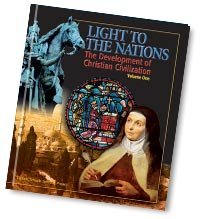 Publisher's suggested grade levels: 7-9
Publisher's suggested grade levels: 7-9
Published in 2008, this text uses an introductory chapter to lay the background for the story of Christian culture. It begins with Adam and Eve, and and so deals briefly with prehistory, cautiously presenting the birth of civilizations without bringing in evolution. This leaves parents the freedom to deal with that topic separately. Within this introductory affiliate, it shows how God revealed Himself in training for his entry into history through the Incarnation. With this background, chapter ane then begins with the birth of Jesus and continues through the establishment of His church.
Against the backdrop of the Roman empire, information technology tells the stories of martyrdoms, evangelization, and the spread of Christianity, primarily through the Eye East, Europe, and Africa. The Rise of Islam receives a proficient deal of attention since the conflict between Christianity and Islam was and remains such a major force in earth history.
The text moves on through the so-called Nighttime Ages to the feudal and medieval periods. Students and so report the rise of nations (Spain, England, and France) and the Crusades, and so the decline and disuse of the Eye Ages that paved the manner for the Renaissance and the Protestant Reformation. Religion and politics both became major factors in the wars that ensued following the Reformation, and the text follows this thread through European history upwards into the early eighteenth century.
The text too includes the creation and expansion of colonial empires, cursory coverage of the American colonies, and chapters on Africa, the Age of Enlightenment, Capitalism, China, Nippon, Latin America, and the Scientific Revolution.
Afterward studying this text, students should have a articulate understanding of the evolution of our western Christian culture. This volume and Calorie-free to the Nations: Function II fill the clear need for a written report of world history that fully acknowledges the vital part Catholicism has played in the evolution of our ain civilization. Although this is not a church history text, students will certainly learn a great deal nearly the development and growth of the Cosmic Church building, key figures in that evolution, and conflicts that accept embroiled and shaped the Church building.
At 574 pages, this is a substantial book. While it might be suitable for some seventh graders as the publisher suggests, I think it will more than probable suit students in grades eight through x. You might want to use this text in ninth grade, Light to the Nations, Part II in tenth class, and Lands of Hope and Promise in eleventh form, and allow time for study of government and economics in 12th grade. You should keep your own scope and sequence in mind as you determine when you might utilize this text.
Light to the Nations, Part Ii: The Making of the Modernistic Globe
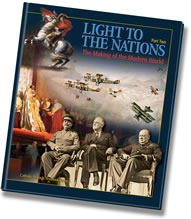 Publisher's suggested class levels: eight-10
Publisher's suggested class levels: eight-10
Part Ii continues the story of world history, picking up with the Age of Enlightenment. History coverage centers on Europe and Russia with attending to other countries and continents simply in relation to them. Fifty-fifty among European countries, France gets more than infinite than other countries. Three of the volume's 20 chapters middle around Napoleon and events concurrent with his time in power!
As with other texts in this series, church history and religious events are also given significant attention. As well, the Enlightenment, the rise of romanticism, and other worldview-related movements are also addressed. All of this helps the reader sympathize historical events within a worldview context.
This text ends with a discussion of the Cosmic Church and the modernistic earth with some fantabulous insights into a Catholic worldview of government and society, specially the concept of religious liberty. However, it skips over most historical events from the late twentieth century to the present. Aside from brief mentions of a few events such as the cosmos of the European Economic Union and the exportation of American culture around the world, it essentially ends with the Communist takeover of Cathay. Given that the virtually recent history is as well omitted from Lands of Hope and Hope, you might want to use other resources to cover the tardily twentieth century and recent
At 650 pages this is definitely a loftier schoolhouse (or fifty-fifty adult) level text. It provides much more detail on the topics information technology covers than do most high school history texts, perhaps besides much for some students; I would not recommend information technology for junior high students. Nonetheless, it is an excellent text for students interested in history and willing to practice the reading.
Lands of Hope and Promise: A History of Due north America
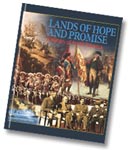 Publisher's suggested grade levels: 9-12
Publisher's suggested grade levels: 9-12
Lands of Hope and Hope is an outstanding history text. Information technology does an fantabulous chore of presenting Usa history with fair coverage of both Protestant and Cosmic views. Information technology is, nevertheless, a Catholic history, so information technology includes stories of St. Elizabeth Seton and Dorothy Day too as coverage of encyclicals that addressed prominent issues in America, especially economic problems. The political tone cannot exist described every bit either conservative or liberal, although there seems to be a fairly potent leaning toward a constitutionally limited government. For example, in reference to Franklin Roosevelt and the New Bargain, the text relates, "The centralization of government in the federal government, dreamed of past Hamilton, begun nether Abraham Lincoln, furthered by the Radical Republicans and Reconstruction, perfected by Teddy Roosevelt and Woodrow Wilson, was virtually to reach its logical practical expression under F.D.R." (p. 758).
The text is quite long for a high school history text. The coverage is thorough, and the author takes the time to brand connections betwixt events and ideas so that readers understand the interplay of events. This is the sort of history we observe more frequently written for adults who desire to truly understand history rather than only rushing through a litany of names, dates, and places.
Lands of Hope and Promise covers through 1973 so wraps upwards the study in an epilogue suggesting topics for students to pursue that pertain to history over the by xl years. The text justifies this unusual approach by explaining that "the author of this history text and its readers…are actors in the drama of contemporary history….Nosotros are caught up in the events we would wish to sympathize. They are too shut to us" (p. 858). It is and then left to the teacher to atomic number 82 discussion or research into a lengthy listing of topics. Mayhap, since students take already read 861 pages to get to this point, some might choose to end the course without addressing more contempo events.
Co-ordinate to the title, this is a "history of N America." While in that location is some coverage of Mexican and Canadian history, about attention is on the United States.
While Lands of Promise and Hope is suggested for grades nine through twelve, considering of the volume's length and depth of coverage, I would recommend it for grades ten and higher up.
Summary
Overall, the Catholic Textbook Projection makes an extremely valuable contribution to Catholic pedagogy—one long overdue and sorely needed.
blaylockneloseling.blogspot.com
Source: https://cathyduffyreviews.com/homeschool-reviews-core-curricula/history-and-geography/u-s-history-core-curricula/catholic-textbook-project
Post a Comment for "Art History Text Book Written From a Catholic World View"